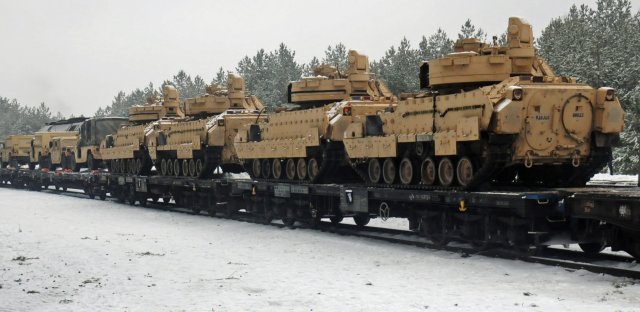
Bradleys of the 4th Infantry Division on a rail car in Poland.
WASHINGTON: The Pentagon has halted planning for the Trump administration’s order to move 12,000 US troops out of Germany, a move defense officials once said was critical to a larger realignment of US posture overseas.
“The previous planning that was ongoing for the previous initiatives that have been put on freeze,” Gen Tod Wolters, European Command chief, told reporters this morning.
Secretary of Defense Lloyd Austin “is at this moment in the process of conducting a very, very thorough review” of the previous planning to move 12,000 troops out of Germany to bases elsewhere in Europe and the US, and “he’ll ultimately embrace our US President and the White House, and deliver us a decision.”
Wolters was one of the officials who extolled the virtues of the pullout in July, when he and then-Defense Secretary Mark Esper presented the plan at the Pentagon. They said it was the result of a long analysis that would make the US more agile, and more effective, on the continent.
Asked about the claims made at the time that the proposed moves were long-planned and in the best strategic interests of the US and its allies, Wolters said today that, “at the time, based off the guidance given, those options that were addressed in the public domain…most clearly addressed the advantages,” of moving forward. “What I will say at this very moment, is that every single one of those options, they’re all on hold. And they will all be re examined from cradle to grave.”
Just an hour after that July briefing at the Pentagon, President Trump blew up all of the carefully prepared explanations, insisting the move was made because “we don’t want to be the suckers anymore, so we’re reducing the force because they’re not paying their bills. It’s very simple, they’re delinquent.”
Trump had nursed long-standing grievances with the government of German Chancellor Angela Merkel over the country’s failure to move toward the NATO pledge of spending 2% of each nation’s GDP on defense by 2024. Try as they might, Pentagon officials were never able to offer a truly convincing rationale for the sudden announcement, aside from President Trump’s personal pique at Merkel.
The former president’s frustration with NATO spending did nudge some allies to at least appear to come closer to meeting the 2024 spending target, and spurred some hard talk within the alliance about modernization programs and Europe’s place in the world. This appears to leave the Biden administration with the benefit of a trans-Atlantic alliance more focused on modernization than it was four years ago.
At the time of the withdrawal announcement, Esper estimated the total cost of the movements would be in the single digit billions, but Vice Chairman of the Joint Chiefs, Gen. John Hyten quickly walked that back.
“The secretary said single digit billions, but those are rough estimates,” Hyten said. “What we have right now is really a concept,” that would take months to refine. In the months after the announcement, defesne officials routinely declined to offer any updates on how planning was proceeding.
During her testimony before the Senate Armed Services Committee on Tuesday, nominee for Deputy Defense Secretary Kathleen Hicks said she watched with “concern,” as the Trump team focused solely on spending per GDP.
“We should always be focused on burden-sharing, ensuring that allies fulfill their commitments,” she said. “But when it becomes that tactical issue that overrides the strategic value of the alliances, alliances that the Chinese and Russians could only hope to match — if we get to that point, we have become astrategic.”
Instead, she advocated that the US takes “a strategic approach to what commitment means. I think we need to make sure that allies are as into the security relationship as we are. Sometimes it’s through spending. Sometimes it’s through defense spending. And sometimes that commitment is expressed in other ways, and I think we should be strategic about how we consider those commitments.”
Overall, the plan would bring roughly 6,400 service members home and reposition 5,600 elsewhere in Europe, including possibly moving troops to the Baltic nations and Poland. The move would leave 24,000 troops in Germany.
In order for that to happen, complex basing and legal issues would have to be resolved with the host nations, a process that could take months, if not years, given the scale of the changes proposed.
The plan included moving 2,000 troops from EUCOM headquarters in Stuttgart, Germany, to Mons, Belgium. Africa Command’s headquarters, also in Germany, is also likely to move to Spain or Italy. Additionally, 4,500 members of the Second Cavalry Regiment in Germany will return to the US and begin rotations in the Black Sea region. Elsewhere, the 2,500 airmen scheduled to deploy to Germany from the U.K. would remain in the U.K., while an F-16 squadron would be sent to Italy.
Wolters today acknowledged that the process was complicated, and “there were so many pieces and parts to the plan we could probably sit here for weeks” talking about “the depth and how far along we were putting in all those cases; there were branches and sequels with multiple options. So I will just tell you that the new administration comfortably stated to us that we need to conduct a thorough review cradle to grave, in all areas.”
Major trends and takeaways from the Defense Department’s Unfunded Priority Lists
Mark Cancian and Chris Park of CSIS break down what is in this year’s unfunded priority lists and what they say about the state of the US military.


























